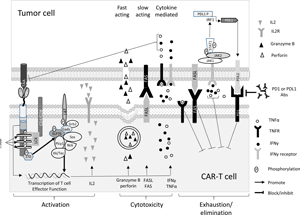Crossref Citations
This article has been cited by the following publications. This list is generated based on data provided by
Crossref.
Mao, Rui
Kong, Wanqing
and
He, Yukai
2022.
The affinity of antigen-binding domain on the antitumor efficacy of CAR T cells: Moderate is better.
Frontiers in Immunology,
Vol. 13,
Issue. ,
Lv, Meng
Liu, Yan
Liu, Wei
Xing, Yabing
and
Zhang, Shengnan
2022.
Immunotherapy for Pediatric Acute Lymphoblastic Leukemia: Recent Advances and Future Perspectives.
Frontiers in Immunology,
Vol. 13,
Issue. ,
He, Changhao
Mansilla-Soto, Jorge
Khanra, Nandish
Hamieh, Mohamad
Bustos, Victor
Paquette, Alice J.
Garcia Angus, Andreina
Shore, Derek M.
Rice, William J.
Khelashvili, George
Sadelain, Michel
and
Meyerson, Joel R.
2023.
CD19 CAR antigen engagement mechanisms and affinity tuning.
Science Immunology,
Vol. 8,
Issue. 81,
Lu, Xiaofan
Song, Bingbing
Weng, Wenjia
Su, Bin
Wu, Hao
Cheung, Allen Ka Loon
Zhang, Tong
and
Gao, Yanqing
2023.
Characteristics of CD8+ Stem Cell-Like Memory T Cell Subset in Chronic Hepatitis C Virus Infection.
Viral Immunology,
Vol. 36,
Issue. 1,
p.
25.
Hussein, Mohamed S.
Li, Qi
Mao, Rui
Peng, Yibing
and
He, Yukai
2023.
TCR T cells overexpressing c-Jun have better functionality with improved tumor infiltration and persistence in hepatocellular carcinoma.
Frontiers in Immunology,
Vol. 14,
Issue. ,
Ma, Tianyin
Chen, Zhang
Chai, Yibo
Gongye, Xiangdong
Xia, Peng
Qu, Chenming
Tian, Ming
and
Yuan, Yufeng
2023.
Research progress on immunotherapy targeting the tumor immune microenvironment for cholangiocarcinoma*.
Oncology and Translational Medicine,
Vol. 9,
Issue. 2,
p.
49.
Smith, Richard
and
Shen, Rhine
2023.
Complexities in comparing the impact of costimulatory domains on approved CD19 CAR functionality.
Journal of Translational Medicine,
Vol. 21,
Issue. 1,
Menasché, P.
2023.
Immunothérapie par CAR-T cells : du traitement des hémopathies malignes à celui des maladies cardiaques ?.
Bulletin de l'Académie Nationale de Médecine,
Vol. 207,
Issue. 1,
p.
82.
Harrer, Dennis Christoph
Li, Sin-Syue
Kaljanac, Marcell
Bezler, Valerie
Barden, Markus
Pan, Hong
Herr, Wolfgang
and
Abken, Hinrich
2024.
Magnetic CAR T cell purification using an anti-G4S linker antibody.
Journal of Immunological Methods,
Vol. 528,
Issue. ,
p.
113667.
Zhong, Ziqiao
Gan, Lu
Feng, Ziyi
Wang, Wenhao
Pan, Xin
Wu, Chuanbin
and
Huang, Ying
2024.
Hydrogel local drug delivery systems for postsurgical management of tumors: Status Quo and perspectives.
Materials Today Bio,
Vol. 29,
Issue. ,
p.
101308.
Dagher, Oula K.
Pedard, Martin
Bedoya, Darel Martinez
Brookens, Shawna K.
Migliorini, Denis
and
Posey, Avery D.
2025.
Preclinical efficacy of multi-targeting mRNA-based CAR T cell therapy in resection models of glioblastoma.
Molecular Therapy Nucleic Acids,
Vol. 36,
Issue. 3,
p.
102676.
Tharian, Leah
Verma, Shiv
Feinberg, Daniel
Parameswaran, Reshmi
and
Gupta, Sanjay
2025.
Chimeric antigen receptor-engineered (CAR)-T cell therapy for metastatic prostate cancer.
Cancer Letters,
Vol. 632,
Issue. ,
p.
217986.
Zhang, Wei
Zeng, Miao
Ma, Xingyu
Chen, Jinghong
Qiao, Jingqiao
He, Ziqian
Zhong, Guocheng
Li, Yisheng
and
Yu, Li
2025.
CLDN18.2-targeting STAR-T cell therapy for pancreatic cancer: a strategy to minimize gastric off-tumor toxicity compared to CLDN18.2 CAR-T.
Oncogene,
Vol. 44,
Issue. 28,
p.
2440.
Hussein, Mohamed Shawky
Mao, Rui
and
He, Yukai
2025.
T Cell Metabolism and Cancer Immunotherapy.
p.
117.
Zhu, Youwen
Liu, Kun
Rosen, Steven T.
Liu, Wei
and
Zhu, Hong
2025.
Treatment-related adverse events of chimeric antigen receptor-T therapies for cancers in clinical trials: a systematic review and meta-analysis.
eClinicalMedicine,
Vol. 84,
Issue. ,
p.
103267.
Hojati shargh, Mohamad mahdi
Mahmoudi, Mahmoud
Agah, Seyed Amir Asef
Forouzanfar, Fatemeh
Javanmardi, Zahra
Fadaee, Afsane
Haghmorad, Dariush
and
Esmaeili, Seyed-Alireza
2026.
CAR T-cell therapy in autoimmune diseases: Opportunities and challenges, with implications for RA.
Tissue and Cell,
Vol. 98,
Issue. ,
p.
103164.


